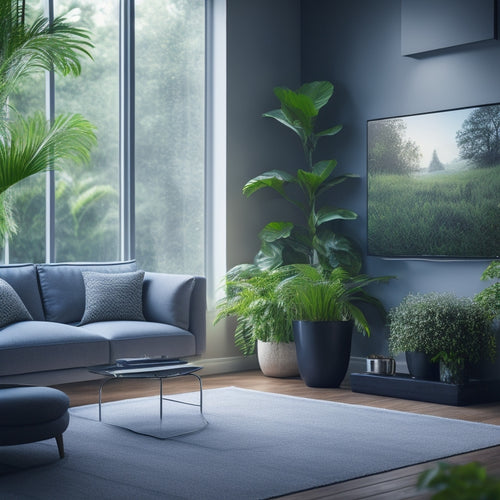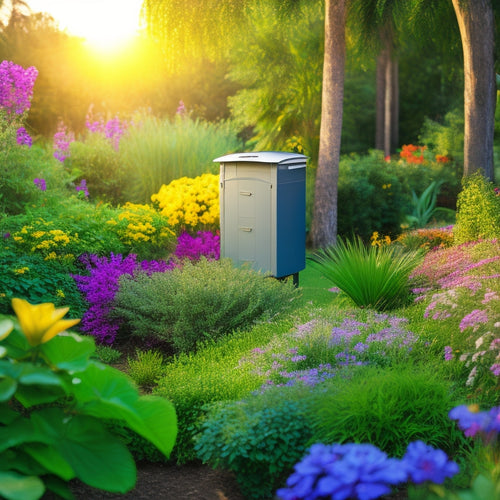
Why Eco-Friendly Homes Need Advanced Ventilation Controls
Share
You're building an eco-friendly home that's highly efficient and environmentally sustainable, but without advanced ventilation controls, you risk compromising indoor air quality, energy efficiency, and even occupant health. Advanced ventilation controls are essential to remove airborne toxins, manage moisture levels, and maintain ideal indoor air quality. They help enhance energy savings by recovering energy from exhausted air, and integrating with smart thermostats to reduce energy consumption. Additionally, they improve air circulation, remove pollutants, and provide a consistent fresh air supply. By incorporating advanced ventilation controls, you can reveal the full potential of your eco-friendly home, and uncover the secrets to creating a truly healthy and sustainable living space.
Key Takeaways
- Advanced ventilation controls optimize energy efficiency by minimizing energy waste and reducing the need for mechanical ventilation in eco-friendly homes.
- Real-time monitoring and adjustment of temperature, humidity, and air quality ensure a healthy and comfortable indoor environment.
- Energy recovery ventilation (ERV) systems and smart thermostats can reduce energy consumption by up to 23% in eco-friendly homes.
- Advanced sensors and automated ventilation control systems provide accurate data for informed decisions about indoor air quality and ventilation strategies.
- Intelligent ventilation systems target pollutants and excess moisture, maintaining optimal indoor conditions and significantly reducing airborne pollutants in eco-friendly homes.
Optimizing Ventilation for Energy Savings
When designing an eco-friendly home, optimizing ventilation for energy savings is essential.
You'll want to incorporate passive design principles to reduce the need for mechanical ventilation systems, which consume energy and increase your carbon footprint. By carefully orienting your home, using natural ventilation strategies, and installing operable windows, you can create a comfortable indoor environment while minimizing energy consumption.
Additionally, integrating energy storage and management systems, such as those used in solar roofing systems, can help reduce reliance on fossil fuels and lower operating costs.
By implementing these strategies, you can create a highly efficient and eco-friendly home that respects the environment while providing you with the freedom to live sustainably.
To further enhance energy efficiency, consider installing advanced ventilation controls that can detect and respond to changes in temperature, humidity, and air quality.
Indoor Air Quality Matters
You're likely aware that indoor air quality has a significant impact on your health and comfort.
To guarantee a healthy indoor environment, it's vital to remove airborne toxins, control moisture levels, and maintain a consistent fresh air supply.
In fact, poor air quality is often linked to respiratory diseases and public health issues, much like the negative effects of urban sprawl on air quality.
Airborne Toxin Removal
By the time you move into your eco-friendly home, airborne toxins have already begun to accumulate, silently compromising indoor air quality.
These toxins can come from various sources, including building materials, furniture, and even personal care products.
Integrating solar-powered EV charging stations solar energy benefits can also contribute to a healthier living environment by reducing reliance on non-renewable energy sources.
To effectively remove them, you need a ventilation system that incorporates advanced toxic particle filtration.
This will greatly reduce chemical exposure and create a healthier living environment.
Look for systems that employ high-efficiency filters and UV light technology to neutralize airborne toxins.
By implementing these measures, you'll be able to breathe easier, knowing your home's air is cleaner and fresher.
With the right ventilation controls, you'll enjoy improved indoor air quality and a greater sense of freedom in your eco-friendly home.
Moisture Control Systems
In tandem with advanced filtration systems, a well-designed moisture control system is vital for maintaining ideal indoor air quality within your eco-friendly home.
You need a system that can effectively manage moisture levels, ensuring your living space remains comfortable and healthy. A well-implemented moisture management strategy involves humidity regulation, which prevents mold growth and structural damage. This is essential, as excessive moisture can lead to indoor air pollution and negatively impact your health.
Furthermore, incorporating renewable energy sources for powering ventilation systems can greatly reduce carbon emissions. By leveraging smart charging systems, you can optimize energy usage and minimize waste.
Fresh Air Supply
Maintaining a consistent fresh air supply is critical to indoor air quality, as it directly impacts the health and comfort of occupants. You need a ventilation system that can provide a reliable flow of fresh air while minimizing energy losses.
Regular maintenance, including cleaning and inspecting connections, is essential for optimizing performance and ensuring longevity, as seen in solar panel maintenance. Advanced ventilation controls can optimize fresh air benefits by ensuring that the air supply is clean, filtered, and free from pollutants.
By incorporating ventilation efficiency into your eco-friendly home, you can reduce the risk of airborne diseases, allergy attacks, and respiratory issues. Additionally, a well-designed ventilation system can reduce moisture buildup, minimize mold growth, and eliminate stale air.
This results in a healthier, more comfortable living space that promotes overall well-being.
Advanced Sensors for Smart Homes
Your smart home's advanced sensors are the eyes and ears that monitor and respond to your environment, ensuring a healthy and comfortable living space.
These sensors employ state-of-the-art technology to detect subtle changes in temperature, humidity, and air quality, adjusting your ventilation controls accordingly.
With seamless smart home integration, your sensors can communicate with other devices to optimize energy efficiency and maintain a perfect indoor climate.
Advanced sensor technology enables real-time monitoring, allowing you to make informed decisions about your home's environment.
Automated Ventilation Control Systems
You'll want to contemplate integrating automated ventilation control systems that continuously monitor air quality and adjust ventilation rates accordingly.
These systems employ advanced algorithms to optimize ventilation strategies, ensuring that your home's air quality is always within a healthy range.
Air Quality Monitoring
Through advanced sensor technology, air quality monitoring systems continuously track pollutant levels, humidity, and temperature within a building, providing real-time data to optimize ventilation control.
You can rely on air quality technologies to detect indoor pollutants, such as particulate matter and volatile organic compounds (VOCs), and monitor their health impacts.
Pollution sensors provide accurate readings, enabling you to make informed decisions about your indoor environment.
Environmental monitoring is essential in eco-friendly homes, as it helps maintain a healthy atmosphere.
With real-time data and air quality indices, you can assess the effectiveness of your smart filtration systems and make adjustments as needed.
Optimized Ventilation Strategies
Air quality monitoring provides the foundation for enhanced ventilation strategies, as it supplies the necessary data to inform automated ventilation control systems. With this data, you can create a customized approach to ventilation that suits your eco-friendly home's unique needs. This may involve integrating natural ventilation strategies, such as operable windows and clerestory windows, with automated systems to maximize efficiency.
| Ventilation Strategy | Description | Benefits |
|---|---|---|
| Natural Ventilation | Employs natural airflow and pressure differences to ventilate the home | Reduces energy consumption, improves indoor air quality |
| Passive Design | Incorporates building design elements to maximize natural ventilation | Lowers energy costs, enhances occupant comfort |
| Hybrid Ventilation | Combines natural and mechanical ventilation for superior performance | Provides precise control, minimizes energy waste |
Energy Recovery Ventilation Benefits
As energy efficiency becomes a top priority in modern homes, energy recovery ventilation (ERV) systems have emerged as a key solution, offering a multitude of benefits that go beyond mere ventilation.
You'll reap significant advantages by incorporating ERV into your eco-friendly home. For instance, ERV systems enable heat recovery, reducing the energy required to heat or cool your home.
This translates to increased energy efficiency, which not only saves you money but also minimizes your carbon footprint. By recovering heat energy from exhaust air and transferring it to fresh air, ERV systems optimize indoor air quality while reducing the load on your HVAC system.
Smart Thermostats for Efficiency
Most modern eco-friendly homes rely on smart thermostats to optimize their heating, ventilation, and air conditioning (HVAC) systems, and for good reason: these advanced devices can slash energy consumption by up to 23%.
You'll appreciate the precision of smart thermostats, which learn your schedule and preferences to fine-tune your HVAC system's performance.
With smart home integration, you can control your thermostat remotely, ensuring your home is comfortable and energy-efficient when you need it to be.
By analyzing your energy usage patterns, smart thermostats can identify opportunities to reduce waste and optimize your system's performance.
HVAC System Optimization Strategies
You've fine-tuned your smart thermostat, but that's only half the battle. To achieve true energy efficiency in your eco-friendly home, you need to refine your HVAC system as a whole. This involves fine-tuning various components to work in harmony.
| Strategy | Description | Benefit |
|---|---|---|
| Zone Control | Divide your home into zones, each with its own thermostat and ductwork. | Reduces energy waste by only heating/cooling occupied areas. |
| Scheduling | Program your HVAC system to operate during specific hours or days. | Saves energy by avoiding unnecessary heating/cooling when you're not home. |
| HVAC Sizing | Confirm your HVAC system is properly sized for your home's specific needs. | Prevents energy waste and reduces wear on the system. |
| Regular Maintenance | Perform regular tune-ups and cleaning to guarantee peak performance. | Prolongs system lifespan and maintains energy efficiency. |
Eliminating Moisture and Mold Growth
Optimizing your HVAC system is only one aspect of creating an eco-friendly home. To truly achieve a healthy and sustainable living space, you must also eliminate moisture and mold growth.
Moisture barriers are vital in preventing water vapor from seeping into your walls and floors, creating an ideal environment for mold growth. By installing these barriers, you're taking an important step in mold prevention.
Additionally, make certain that your home's envelope is tightly sealed to prevent air leaks, which can exacerbate moisture issues. By controlling moisture levels, you'll not only prevent mold growth but also reduce the risk of structural damage and indoor air quality issues.
Fresh Air Supply and Exhaust
Three key components of a well-designed fresh air supply and exhaust system are critical to maintaining a healthy indoor environment: a controlled ventilation rate, a balanced airflow, and a filtration system.
You'll want to confirm that your system provides a consistent flow of fresh air, while also removing stale air and pollutants. This can be achieved through advanced air circulation techniques, such as heat recovery ventilation systems, which optimize energy efficiency.
Energy efficient designs, like passive house ventilation, can also help reduce energy consumption while maintaining indoor air quality.
Intelligent Ventilation for Health
You're probably aware that poor indoor air quality can exacerbate respiratory issues and even cause long-term health problems.
Intelligent ventilation systems can provide clean air that matters, creating breathing easy spaces that promote well-being.
Clean Air Matters
Breathing in polluted air can be detrimental to your health, as it can trigger respiratory issues, exacerbate existing conditions, and even lead to long-term damage. You deserve better.
That's why air purification is essential in your eco-friendly home. Advanced ventilation controls can remove pollutants and allergens, providing a healthier indoor environment.
By integrating air purification systems, you can reap significant health benefits, including reduced respiratory problems, improved sleep quality, and enhanced overall well-being.
Proper ventilation also helps eliminate moisture, reducing the risk of mold growth and structural damage.
With intelligent ventilation, you can breathe easy, knowing your home is a sanctuary for your health and freedom.
Breathing Easy Spaces
Within your eco-friendly home, intelligent ventilation systems create a health haven by cleverly controlling airflow, thereby ensuring a perpetual supply of fresh air.
You can breathe easy, knowing that advanced sensors monitor indoor air quality, detecting pollutants and excess moisture. This triggers the system to adjust ventilation rates, introducing natural airflow and maintaining ideal indoor conditions.
Sustainable design principles guide the system's operation, minimizing energy consumption while maximizing air exchange.
As you move through your home, the ventilation system adapts, ensuring a consistent flow of clean air.
This collaboration of technology and nature creates a haven where you can thrive, free from the constraints of poor air quality.
Healthier Indoor Air
Intelligent ventilation systems pinpoint pollutants and excess moisture, triggering precise adjustments to airflow and introducing natural ventilation to maintain ideal indoor conditions.
You deserve to breathe easy in your eco-friendly home, and advanced ventilation controls make it possible.
By precisely managing air exchange, you'll enjoy a significant reduction in airborne pollutants, excess moisture, and stagnation.
This means you'll reap the health benefits of fresher, cleaner indoor air, free from the respiratory issues and allergies that can come with poor ventilation.
With intelligent ventilation, you can trust that your indoor air is healthy and revitalizing, giving you the freedom to live life to the fullest.
Frequently Asked Questions
Can Advanced Ventilation Controls Integrate With Existing HVAC Systems Seamlessly?
You'll find that advanced ventilation controls can indeed integrate seamlessly with your existing HVAC systems, optimizing energy efficiency and indoor air quality while giving you the freedom to breathe easy and live comfortably.
How Often Should Air Filters Be Replaced in Eco-Friendly Homes?
Fresh frequencies of filter maintenance are essential: you should swap out stale filters every 1-3 months, depending on usage, to safeguard indoor air quality and guarantee your eco-friendly abode remains a haven of healthy, happy breathing.
Are Smart Ventilation Systems Compatible With Older Homes?
You can retrofit older homes with smart ventilation systems, ensuring seamless smart home integration and ideal energy efficiency, by selecting compatible devices and consulting with experts to guide through any unique installation requirements.
Do Advanced Sensors Detect and Respond to Humidity Levels?
You'll find that advanced sensors in smart ventilation systems detect humidity levels with precision, responding swiftly to maintain ideal moisture management, ensuring your indoor air quality remains fresh and healthy, free from mold and mildew.
Can Automated Ventilation Control Systems Be Controlled Remotely?
You can control automated ventilation systems remotely, leveraging remote access to optimize energy efficiency and indoor air quality; this flexibility allows you to adjust settings from anywhere, ensuring your space stays comfortable and sustainable.
Related Posts
-

7 Best Home Hydrogen Fuel Cells for Clean Power
You're considering adopting hydrogen fuel cells for clean power at home, but you want to know the best options. Reput...
-

Why Choose Solar Composting Toilets for Your Home?
By choosing a solar composting toilet for your home, you'll greatly reduce your environmental impact, slashing your w...
-

10 Best Energy-Efficient External Hard Drives for Sustainable Offices
When it comes to sustainable offices, you need external hard drives that balance data storage needs with energy effic...


